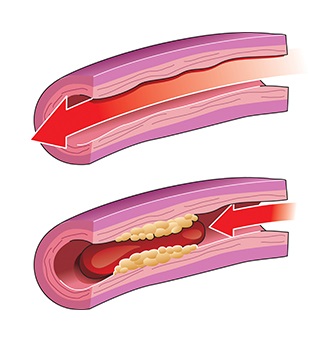High blood cholesterol is one of the major controllable risk factors for coronary heart disease, heart attack and stroke.
As your blood cholesterol rises, so does your risk of coronary heart disease.
What is blood cholesterol?
Cholesterol is a fat found in the blood. There are two main types of blood cholesterol: high density or HDL cholesterol and low density or LDL cholesterol.
High levels of LDL cholesterol, known as ‘bad’ cholesterol, can form plaque or fatty deposits on your artery walls and block blood flow to the heart and brain.
HDL cholesterol is referred to as ‘good’ cholesterol because it helps to remove LDL cholesterol from the body.
Your body needs a certain amount of cholesterol, which your liver makes. Cholesterol can also be increased by the food we eat. Too much cholesterol can increase your risk for heart disease.
Dietary cholesterol — found in meat, poultry, eggs and regular dairy products — have less impact on blood cholesterol than foods with saturated and trans fat.
Saturated fats are found in highly processed foods, fatty meats, full-fat milk products, butter and lard. Foods containing trans fat include partially hydrogenated margarines, deep-fried foods and some packaged snacks and baked goods. Many countries, including Canada, have banned added trans fat, therefore as consumers, it’s not something we need to worry about.

Normal blood flow through healthy artery (top) and blocked blood flow in artery with yellow plaque and red blood clot (bottom).
Diagnosis
Understand your risk
The only way to know if you have high cholesterol levels is to have a simple blood test.
Canadian guidelines recommend having your cholesterol tested if you:
- are over the age of 40
- are younger than 40 and one or more of the following factors applies to you:
- high blood pressure
- diabetes
- hardening of the arteries (atherosclerosis)
- kidney disease
- hypertension disorder during pregnancy
- smoking
- family history of heart disease or stroke
Understand your test results
Your test results will include:
- HDL cholesterol (good cholesterol) - good to have a high number
- LDL cholesterol (bad cholesterol) - good to have a low number
- Non HDL cholesterol (total cholesterol – HDL cholesterol) - good to have a low number
- Triglycerides - a high triglyceride reading combined with high LDL and low HDL could increase your risk for heart disease.
Your doctor will review your test results along with your risk factors, medical history and present health.
Familial hypercholesterolemia or inherited high cholesterol
If you have familial or inherited high cholesterol levels, you have a much higher risk of developing heart disease early in life.
If you or a family member have a history of premature heart disease or very high cholesterol at a young age, talk to your healthcare provider about whether genetic testing is right for you. If you or a family member is diagnosed with familial hypercholesterolemia, it’s very important to be treated early.

Dr. Heit thinks immune system could hold key to preventing heart attacks.

Prevention and management
Making some lifestyle changes is a positive way to control your blood cholesterol levels.
What you eat has a huge impact on your health. Highly processed foods are a major source of saturated fat and are usually high in calories, salt (sodium) and sugar. Saturated fat increases LDL or bad cholesterol levels in the blood.
Heart & Stroke recommends that you:
1. Eat a healthy balanced diet.
- Choose a variety of whole and minimally processed foods at every meal and snack. These are foods that are recognizable in their original form or have few ingredients.
- Fill half your plate with vegetables and fruit at every meal. Choose vegetables and fruit for snacks, using fresh, frozen or canned without added sauce, sugar or salt.
- Choose whole grains. Look for whole grain breads, barley, oats (including oatmeal), quinoa, brown rice, bulgur, farro, etc.
- Mix up your plate. Choose vegetarian options such as beans, lentils, tofu and nuts more often. When eating meat, go for lean cuts, poultry without the skin and include fish a couple times a week. Watch your portion sizes.
- Choose lower fat dairy products or alternatives with no added sugar. Select 1% or skim milk, plain yogurt and lower fat cheeses.
- Plan smart snacks. Pair two different food types like hummus and carrots, apple slices and low fat cheese or plain yogurt with berries.
- Drink water or lower fat plain milk to satisfy thirst.
- Avoid sugary drinks including soft drinks, sports drinks, sweetened milk or alternatives, fruit drinks, 100% fruit juice and ready-to-drink sweetened coffees and teas.
- Note: If your blood cholesterol level is high, your physician or dietitian may recommend cutting back on foods that are high in dietary cholesterol such as egg yolks, organ meats, full- fat dairy products and processed meats.
2. Cook and eat more meals at home
- Cooking at home allows you to select whole and minimally processed foods.
- Develop and share skills in food preparation and cooking with your family.
- Buy a healthy cookbook or try some of our healthy recipes.
- Select the top ten recipes your family loves and get everyone involved in the meal preparation.
- Reduce the amount of sugar, salt and fats used in your favourite recipes.
3. Make eating out a special occasion
- Eating out can sometimes mean larger amounts of food, more fat, salt, sugar and less fibre.
- Try to limit the number of times you eat out.
- When you do eat out, choose places that serve freshly made dishes using whole and minimally processed foods and provide nutrition information.
- You can also make healthier choices by sharing meals, ordering a smaller portion or packing up half to enjoy later.
4. Achieve and maintain a healthy weight
Maintaining a healthy weight can support better cholesterol levels. Carrying extra weight may raise LDL (bad cholesterol), lower HDL (good cholesterol) and increase triglycerides. Making small, sustainable changes to your eating habits can have a positive impact on your health.
5. Maintain physical activity
Being physically active will help improve your HDL cholesterol levels and general heart health. Aim for 150 minutes of moderate to vigorous physical activity a week. That is less than 25 minutes per day!
Choose activities you like. Cycling, swimming, gardening, walking are great ways to keep active.
6. Be smoke-free
Quitting smoking is one of the best things you can do for your health as it’s a risk factor for heart disease. Smoking reduces the level of your HDL “good” cholesterol. Once you quit, within a few weeks your HDL levels will start to improve.
Nutrition labelling
Most packaged food will have an ingredient list, in starting with the ingredient in the highest amount.
The package will also contain a Nutrition Facts Table that provides information on a single serving size and the calories and nutrients a serving contains.
All of the nutrient information is based on a single serving. You'll find information on the amount of fat, cholesterol, sodium, carbohydrate, fibre, sugars, protein and some vitamins and minerals.
When reviewing the Nutrition Facts Table on a package, always look at the sodium values. If you have a high cholesterol level, you may also need to look at the cholesterol value. The % Daily Value on the label will tell you whether there is a lot or a little of a nutrient in a single serving. 15% or more is a lot and 5% or less is a little.
Plant sterols
Research shows that plant sterols can help lower LDL “bad” cholesterol.
Plant sterols occur naturally in small amounts in vegetable oils, nuts, whole grains, vegetables and fruit.
It's recommended that you consume 2g of plant sterols per day to help lower your LDL cholesterol.
It's not possible to obtain enough plant sterols naturally from foods.
Foods in Canada are now allowed to have up to 1g of plant sterols per serving added to them. Look for foods fortified with plant sterols such as mayonnaise, margarine and salad dressing
Dietary fats
Dietary fats and oils provide our bodies with energy, provide essential fats and help absorb fat soluble vitamins such as A, D, E and K.
There are different types of fats:
- polyunsaturated fats (omega-3 and 6)
- monounsaturated fats
- trans fats
- saturated fats
Both the quality and amount of fat you eat matters. It is important to not focus on just one nutrient – it is your overall diet that will make the biggest difference to your health. For example, foods marketed as “low fat” can be highly processed and contain lots of refined carbohydrates, calories, sugar and sodium.
Choose more often: polyunsaturated fat (omega-3)
Food sources:
- fatty fish: salmon, trout, mackerel, sardines, herring
- oils: canola, soy, sunflower, flaxseed
- nuts and seeds: walnuts, flaxseeds (ground), chia seeds
- legumes: soybeans and tofu
- omega-3 fortified products: omega-3 soy beverage, omega-3 yogurt, omega-3 eggs
Choose more often: monounsaturated fat
Food sources:
- fats and oils: olive, canola, peanut, safflower, sesame, non-hydrogenated margarines made from these oils, salad dressings made from these oil
- nuts, nut butters and seeds: almonds, pecans, hazelnuts, peanuts, pine nuts, sunflower seeds
- avocados
Eat in moderation: polyunsaturated fats (omega-6)
Food sources:
- fats and oils: safflower, sunflower, corn
- legumes: soybeans
- nuts and seeds
Choose less often: saturated fats
Food sources:
- fatty meats
- full-fat dairy products
- fats and oils: butter, hard margarines, lard, coconut oil, ghee, palm oil
- highly processed foods are a major source of saturated fat and are also usually high in calories, sodium, sugar and sometimes trans fat:
- processed meats such as sausages, bologna, salami, hot dogs, liver, meat pate
- prepared foods
- snack foods
- chocolates and sugary drinks.
The majority of our saturated fat intake comes from highly processed food intake. Saturated fat intake should not be an issue if you are eating a healthy, balanced diet, few or no highly-processed foods and appropriate portion sizes.
Medication to lower cholesterol
Sometimes diet and exercise are not enough to lower your blood cholesterol levels. Several medications are available to lower your blood cholesterol. Your doctor may prescribe medications including statins and other cholesterol lowering medication.
These medications do not cure high blood cholesterol or replace a healthy lifestyle.
Related information
How to manage your cholesterol (PDF)
Find health eating tips here
Learn more about other risk factors for heart disease
